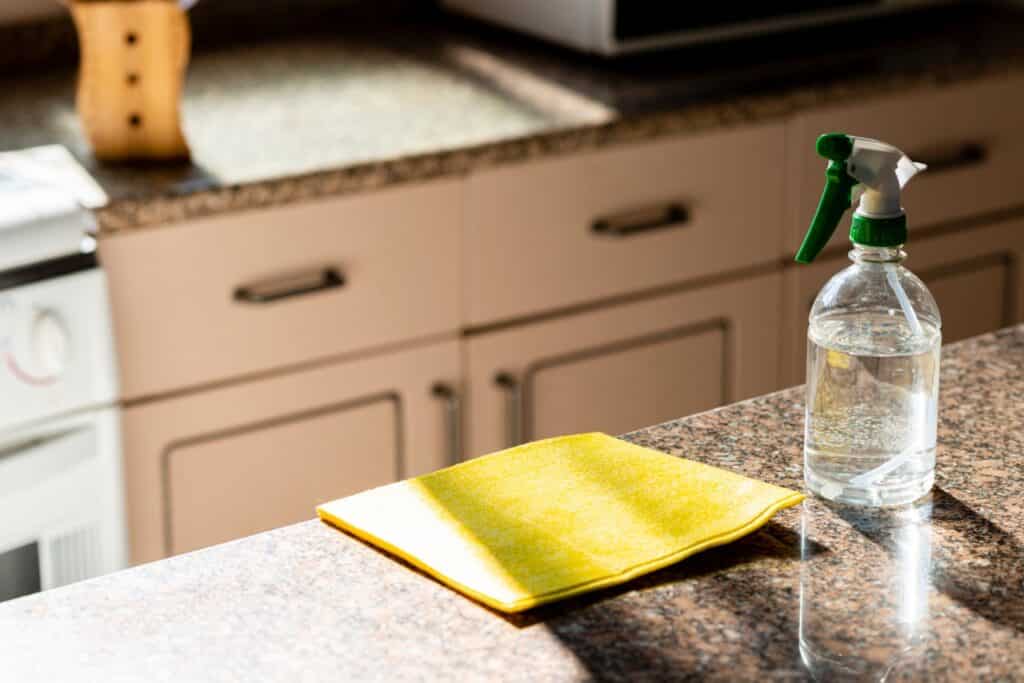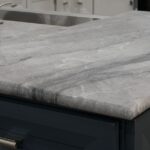Removing stains from granite countertops is possible, can be done at a home and you should definitely know all about it. That’s why we have prepared this insanely complete guide on how to remove stains from your granite countertops. All so you can use in order to try and remove various different kinds of stains.
That’s right, the technique to remove stains from granite surfaces is not a “one size fits all”, it will be slightly different depending on which kind of stain you’re dealing with and how deep it has penetrated. But don’t worry, we will teach you all about how to identify the stain perpetrator and how to remove those stains from your granite countertops.
This is the guide you should save for future use. You might also want to read our complete guide on how to avoid stains: “How to Clean Granite Countertops”. If you’re looking for more tips on how to take care of your countertop, we also have our definitive guide on granite countertops!
Understanding Granite Stains
Granite is a porous material, that means it can absorb water and other liquids and makes it susceptible to stains. However, it’s important to remember granite is one of the less porous natural stones, and provided it’s properly sealed it won’t stain at all.
Kitchens are always full of liquids prone to stain a natural stone such as fruit juices, wine, coffee, tea, water, vinegar, vegetable and olive oils, ketchup, BBQ sauce, etc., and that makes it really hard to avoid stains unless your stone is sealed.
Find out more about sealing by reading our article: “How To Seal Granite Countertops”.
Stains happen when unsealed granite surfaces absorb liquids that have been sitting on it for too long. Now, simple water stains shouldn’t be much of a problem, since they will evaporate quickly, thus leaving the stone without causing any visual damage. The real baddies here are oil, rust, hard water stains and others that won’t completely evaporate.
Fortunately, those can sometimes be removed with the techniques we’re about to share.

Etch Or Stain?
Before you try to remove that stain, you need to find out if it’s a stain or an etch.
A stain comes from pigments and particles that find their way into the stone’s pores. They generally make the stone darker wherever they settle in. Stains are something you can remove, although it may take some effort, because it’s just a matter of taking out those particles.
Etches, on the other hand, are actually the result of chemical damage. Some strong chemicals and some kinds of acidic foods can react with the stone, especially if it’s not well sealed, and permanently change its composition on the surface. They generally make the stone’s color lighter.
As etches appear because of chemical reactions, the methods we’ll talk about don’t apply to them, as you can’t really revert those reactions. The only way to remove etches is to get the stone polished.
If you’re unsure, get in touch with professionals in order to identify whether it’s a stain or etch and figure out the best way to deal with it.
how to remove stains from your granite countertops
Plenty of different materials might be responsible for staining your granite countertops. Thus, the procedure to remove those stains will be slightly different depending on that.
With that said, you should try to identify the perpetrator and use our recommended procedure for it.
Oil-Based Stains
These stains tend to darken the stone’s surface and be very hard to remove, since oils don’t evaporate easily.
An oil-based stain might be caused by grease, cooking oil, milk, peanut butter, creams, cosmetics and so on. And the only way to remove it is drawing out the oil from the granite countertop.
Clean the area with a soft liquid cleanser mixed with drops of ammonia or acetone. If that doesn’t work, applying a special poultice for a few days might do trick. We will dedicate an entire section of this post to teaching you how to do that.
Organic Stains
These stains originate from coffee, tea, wine, foods and other organics, they are pink to brown and definitely easier to remove than oil-based stains.
Spot clean the stained area with 12% hydrogen peroxide mixed with a few drops of ammonia. Be careful not to discolor darker stones, because hydrogen peroxide is powerful enough for that. After finishing rinse the area and dry it completely.
Again, if this spot cleaning does not do the trick, it’s possible that a poultice application can do it. More on that later on.
Biological Stains
You should opt to fight mold and mildew with especially designed granite mold removers. That’s your safest choice. However, if the product turns out not to be strong, we recommend that you call in stone pros.
Some websites suggest applying a solution that contains bleach, however, if you do that, you’re in for a huge chance of causing damages to the area. It’s best to let professionals take care of your issue and preserve your investment.
Ink and Paint Stains
Ink stains (from markers and pens) or even paint stains can be removed using hydrogen peroxide or lacquer thinner. While the former is better for whiter stones, the latter is better for darker stones. Again, these are strong chemicals, so use them in spots and take care not to discolor your countertops.
If the paint stain is superficial, you can try scraping it off with a razor blade. If everything else fails you should also try the poultice application.
Super Glue Stains
If you ended up getting some super glue stuck on your granite countertop, worry not! You can also remove it very easily.
To do that, damp a cotton swab with rubbing alcohol and carefully scrub the glue with it. Rubbing alcohol is able to break it down, making it easier to clean. Use the alcohol to make the glue softer, then use a damp cloth to remove it as it softens. Do it quickly and carefully. If you leave rubbing alcohol for too long on the stone, you may end up etching it!
Rust Stains
Rust stains are easy to identify they are colored like copper and tend to present themselves in the form of the metallic items that were on top of your granite countertop until you noticed they were staining it.
Sadly, these stains are very hard to remove, they may be permanent. Your best choice is trying the poultice solution.
Water Spots and Rings
Since there’s no way to know for sure how stubborn your stain really is, we will start with simple tips and techniques and move on to more complex solutions.
Scrubbing with water and detergent
This simple fix is the first you should try. Use a bristled brush to scrub the stain with gentle detergent (dishwashing type, for instance) and water.
That is to say: if it gets the job done, great!
Scrubbing with a special paste
Make a paste of baking soda and water, or talc with a diluted solution of ammonia, bleach or hydrogen peroxide. Use a soft brush to scrub the stain with the paste and then rinse it thoroughly.
If you’re getting results from this procedure, repeat it until you’re satisfied with the progress.
Scraping superficial deposits
If you notice that the water rings are sitting on the surface, you can resort to more abrasive techniques to try and remove them. For instance, you can scrub softly with a Brillo pad and scrape with a razor blade.
If all else fails, you should also try the poultice application.
how to remove resilient stains from your granite countertops with poultice
When the stain has sunk in deep enough just applying products to the surface of the granite won’t be enough to suck it out. However, using an appropriate poultice and leaving it there for a few days might do the trick.
The poultice is prepared by mixing water, baking soda and a liquid solvent that’s appropriate to the type of stain you’re dealing with. Your goal is to make it the same consistency of peanut butter. See below a table of which liquid solvent to mix in order to remove the types of stain we discussed.
| Type of Stain | Liquid Solvent |
| Rust Stains | Rust Remover Liquid |
| Oil Based Stains | Acetone |
| Organic Stains | 6% Hydrogen Peroxide |
| Ink or Paint Stains | 6% Hydrogen Peroxide |
| Hard Water Stains | 6% Hydrogen Peroxide |
Apply the poultice to the stained area forming a ¼ to ½ inch thick coating. Then, extend this coating beyond the stained area by at least 1 inch. Cover it with plastic and tape it for sealing.
After 24 hours, remove the plastic and let the poultice dry for another 24 hours. Most importantly, the drying process is what pulls the stain out of the stone and into the material.
Then, remove the poultice, rinse it with water and buff dry with a soft cloth. And, check how it affected the stain, it might take up to 5 applications to remove it thoroughly.
At last, for detailed instructions check out this video from the Marble Institute of America (now, The Natural Stone Institute).
Complete Granite Countertop Restoration
If your stains are too deep for these techniques, don’t fret, because that’s not the end.
You can hire professionals to hard polish your whole countertop, making it look like new again, only a fraction thinner. So, find out all about polishing granite countertops on our article: “How Granite Is Polished”.
If you live in Sarasota, FL, or surrounding cities, our team at Eagle Stones is eager to help you. Get in touch or visit our showroom.
FAQ
Yes, you can! But you need to find out what caused the stain first. There are many possible ways of removing stains from granite, and to pick the right one you need to find out what caused it.
No! Bleach is too strong, and is likely to leave an etch. Etches can only be removed by polishing the stone again.
Yes! There many methods that you can do at home, and they can give you great results! Some stains can be harder to remove than others, so, if a stain is being stubborn, be sure to call professional stone cleaners.



